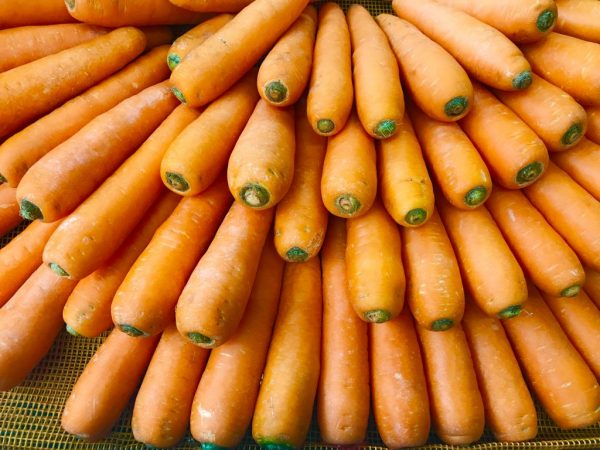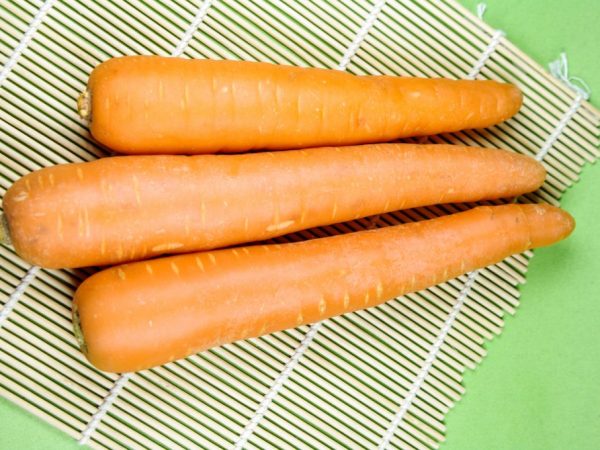Characteristics of Abaco carrots
The Abaco carrot is a medium-ripening variety. A temperate climate is suitable for its cultivation. One of the main advantages of the variety is a good presentation of the fruit. There are other positive characteristics that a gardener should know about.

Characteristics of Abaco carrots
Characteristics of the variety
Abaco f1 is a hybrid bred in Holland as a result of crossing Kuroda and Shantane varieties.
Abaco is a new species with a short growing season and good germination. Fruits are harvested within 100-110 days after planting the seeds. Also, the variety is frost-resistant, root crops do not freeze even at -3 ° C.
The Abaco variety has a high yield, up to 95% of the sown seeds sprout. This is a high indicator relative to other types of carrots.
Fruits of the variety are well suited for machine picking. But he needs loosening of the soil, good watering and feeding.
Advantages of the variety:
- good commercial qualities;
- good keeping quality;
- excellent taste;
- disease resistance.
Description of the bush
The plant has spreading foliage of bright green color. The length of the tops reaches 60 cm, strong.
According to the description, the variety is not prone to color (the appearance of a flower shoot in the first year of the growing season). Also, the plant resists the appearance of spotting on the leaves well. The plant is not prone to shooting.
Description of fruits
The fruits are oblong, smooth skin and rounded at the end. There is a small core inside. Fruit length 18-20 cm, diameter 4-6 cm.
The color of the fruit is bright orange inside and outside. The pulp is juicy and firm.
Abaco carrots are consumed both raw and processed. Suitable for harvesting, goes well with other vegetables. Stored for a long time when frozen, without losing taste. Due to the bright color of the fruits, Abaco f1 is used in the processing industry.
Growing varieties

Seeds are planted very early
Due to its high frost resistance, sowing begins immediately after the last frost. The optimal period is in April-early May.
Organic and clayey soil is suitable for growing Abaco. It is important that the groundwater is located at a distance of 1-3m. For planting, they take an area where tomato, onion, potato or cabbage were previously grown.
Disembarkation
It is better to choose a place for planting carrots in the fall. To increase the amount of the crop, mineral fertilizers, humus, ash (0.2 kg / 1 m2) are used.
The following deoxidizers are also added:
- dolomite;
- lime;
- a piece of chalk.
Abaco f1 does not bear fruit well if the soil pH is below 6. It is possible to reduce the acid reaction by introducing compost and peat. Freezing the land will help prevent the appearance of the number of weeds and pests.
Before sowing, the plot is leveled with a rake and furrows are made with a depth of 3 cm. The distance between rows is 20 cm. Before sowing, the soil is watered abundantly. This is done to compact the bottom of the furrows.
Abaco carrot seeds are soaked before sowing. It is better to do this in melt water, it stimulates growth well. They are wrapped in a napkin and left to saturate with water for 3 days.
The seeds are laid out in prepared furrows and covered with earth. Then the bed is sprinkled with heated compost. Fertilizer is poured with a slide and tamped slightly.
Care
Protection
In spring, the garden bed is protected from cold snaps and winds at night. This is done using a covering material. Arcs provide warm air above the soil, if they are not there, use lumber, raising the shelter by 5-10 cm.
It is better to use agrofibre as a shelter. It effectively retains moisture and prevents crusting. Thanks to such a shelter, the seedlings will be protected not only from the wind and will sprout evenly. After emergence, the shelter is removed.
Fertilizer
The first fertilizer is applied to the soil 2 weeks before sowing.
Fertilizer selection:
- Humus, peat or sawdust are added to clay and podzolic soil. 2 Art. tablespoons of nitro phosphate and 1 tbsp. a spoonful of superphosphate per 1 m².
- Sawdust, sand or humus are introduced into the peat soil. They also take 1 tbsp. a spoonful of superphosphate, 1 tbsp. a spoonful of potassium chlorine, 1 teaspoon of urea.
- Sawdust and sand are added to black soil, as well as 2 tbsp. tablespoons of superphosphate. A mixture of nitrogen and phosphorus is introduced into the sandy soil.
During the growing season, 2 dressings are applied. Carrots especially need nitrogen and phosphorus. Introducing potassium salt, complexes with a low chlorine content are used.
But nitrogen fertilizers are applied carefully, because their excess weakens the root system, the tops wither, and the taste of the fruit deteriorates. Therefore, only liquid top dressing is applied, watering the aisle.
Fertilization:
- for the first feeding, take 150 g per 1 m2, of which: potassium - 60 g, nitrogen - 50 g, phosphorus - 40 g;
- for the second feeding, less fertilizer is taken: nitrate - 20 g, potassium chloride and superphosphate 30 g each.
Watering
Abaco carrots love moisture. Irrigation is carried out every 10 days. In wet weather, water less often.
Lack of moisture leads to cracking and deformation of the fruit. Timely watering is important to ensure the presentation of the fruit.
Diseases and pests

This variety is resistant to disease
Abaco f1 is resistant to diseases and pests, but it should be protected from the infestation of the carrot fly. Also, the plant is subject to diseases such as powdery mildew and phomosis. The fight is carried out in a complex.
After harvesting, the soil is well dug up, all the remains of the tops are destroyed. Also, to prevent the development of diseases, follow the rules of crop rotation.
Treatment of diseases
To prevent the appearance of phomosis, during the autumn digging of the site, potassium chloride (40 g per 1 m2) is introduced. And 1.5-2 weeks before harvesting, fertilizing with potassium chloride is carried out. Potassium fertilization also helps to prevent powdery mildew.
It is also important to store the crop properly. The fruits are sprinkled with a layer of sand and covered.
Pest control
One of the most dangerous pests in carrots is the carrot fly. The affected vegetable should not be eaten, it acquires a bitter taste.
Effectively get rid of carrot flies with folk remedies. A mixture of tobacco dust, ash and lime helps. For 1m² take 5-10 g of funds. Sprinkle the soil 3 times with a break of 10 days.
Prophylaxis
Nettle infusion is used as a preventive measure for diseases. It is added to water for irrigation at the rate of 0.5 liters per 1 watering can.
The leaves are sprayed with Immunocytophyte. It helps the plant to resist the carrot fly. They are processed in June and repeated after 2 weeks. Biological products with a wide spectrum of action help to resist infectious diseases.
Conclusion
Carrots Abaco f1 managed to gain popularity among many gardeners. It has an attractive appearance and good taste, and the seeds of this variety are stored for a long time without losing quality.
This variety is not difficult to care for, it rises early and has a high yield. Abaco is resistant to most diseases and is rarely attacked by pests.


